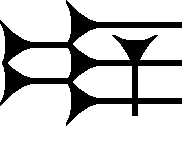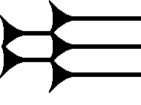
The cuneiform sign for tur is used to denote one syllabic usage, tur, or the sign's Sumerograms; it is used in the Epic of Gilgamesh and the 14th century BC Amarna letters. The sign is based on the i (cuneiform) sign, with the one small added vertical stroke.
Contents
Besides tur, it is for Sumerograms (logograms) BÀN, DUMU, and TUR. In the Epic of Gilgamesh, it is used in the following numbers: tur-(11 times), BÀN-(3), DUMU-(25), TUR-(2). [1] The large usage of DUMU in the Epic is for the Sumerogram being the equivalent of "son", Akkadian language "māru". [2]
